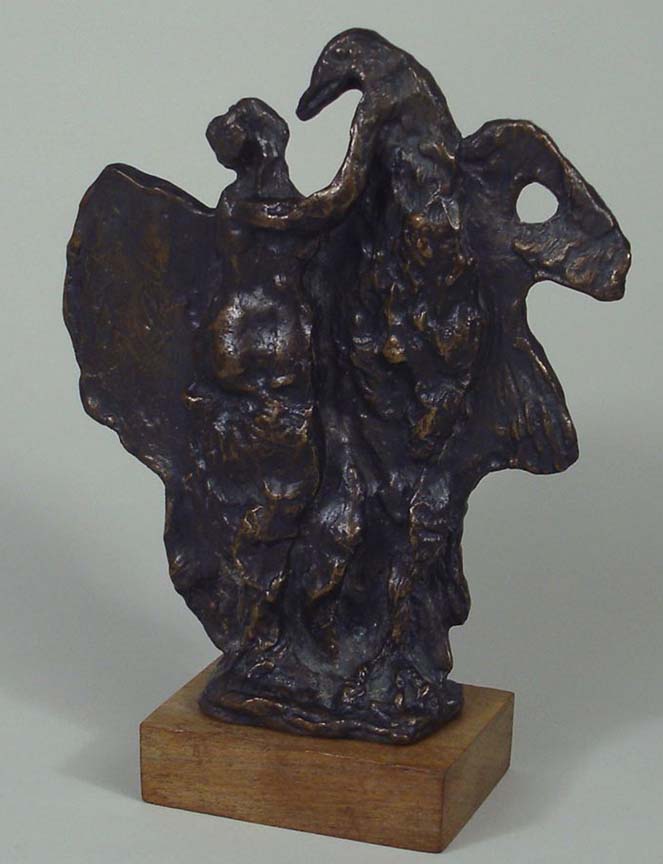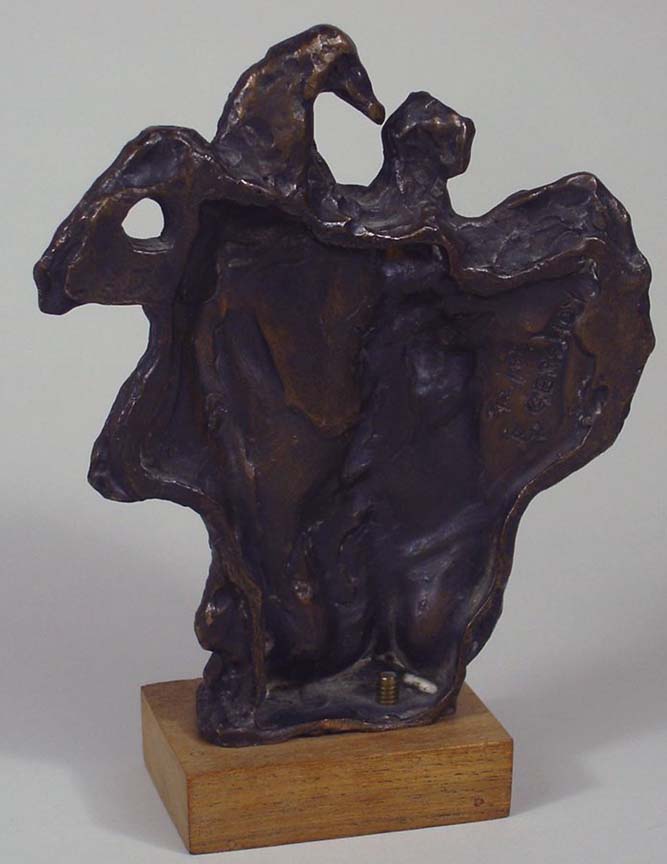

EUGENIE GERSHOY
"LEDA AND THE SWAN"
BRONZE, SIGNED, NUMBERED
AMERICAN, C.1980
8 INCHES OVERALL

The following is submitted by Cornelia Seckel, publisher Art Times Profile: Eugenie Gershoy By RAYMOND J. STEINER Art Times November 1984 EUGENIE GERSHOY: an emigre from a pogrom-threatening Russia, a member of a distinguished family of the intelligentsia, a life-long artist whose career began before the age of four, a woman of eclectic tastes and cultured learning seasoned with a loving and satirical eyehow and where does one begin to capture her in all her facets? Largely a natural talent with a smattering of formal training, it has been through sheer force of her irrepressible creativity that she has attained a stature and versatility in the world of art that few can match. Represented in almost every major collection (the Whitney Museum of American Art, the Metropolitan Museum of Art, the National Museum of American Art, the Syracuse Museum of American Art, the Delgado Museum of Art, Skidmore College of Fine Art, to name a few), she has exhibited her work in numerous shows from New York and west to San Francisco and south to New Orleans, culminating in her most recent, a special show of her sculptures entitled "Fantasy and Imagination in Sculpture" at the Smithsonian Institute in Washington, D.C. which will continue until January 20,1985. Honors and awards began as early as 1914 when she received the St. Gaudens medal for fine draftsmanship and have continued throughout her career of creating, of teaching and active membership in over twenty gallery and art associations. A recent article in the Smithsonian was the last of almost fifty such pieces on either herself or on her art in various publications from across the country and from as early as the'30's. The astonishing diversity of her life's work is scarcely hinted at in the accompanying photographs. To select any one aspect of Ms. Gershoy's life or work would, of course, lead to distortion and an incomplete picture of her contribution. Fortunately, in addition to being a fine artist, she is highly literate and capable of verbalizing her own growth and artistic concepts, sharing copious notes that she has saved over the years. (An example of her writing and expressions on art can be found in the "SPEAK OUT" section of this issue of ART TIMES.) A chronological highlighting of her career, therefore, seems the only way to do her justice. Exposed to the "masters" in a collection of art books owned by her parents, Ms. Gershoy "drew assiduously from the age of three on" At five, she was copying Michelangelo, Rafael, and daVinci never suspecting that these were, in fact, reproductions of sculpture in three dimensions. Eventually, she drew from life, adding a lively sense of color as she experimented with crayons, colored inks, watercolors, and oils. At thirteen, she set about illustrating "Little Women." Resolving to become a painter and illustrator, she took advantage of a scholarship and entered the Art Students League of New York. Disappointed that the painting class was full, she turned to leave only to be stopped by a young woman who suggested she take a modeling course instead. "What is modeling?" was her immediate response, not having any knowledge of sculpture up until that point. The young woman was Hannah Small Ludins (a sculptor featured in the September issue of ART TIMES) and through their association in the modeling class of A. Stirling Calder, became life-long friends. A second year's scholarship, however, could not keep her within the confines of a classroom, and she left shortly after for Woodstock, NY where, under the auspices of Hervey White and the arts colony, she came under the influence of sculptor John Flannagan. Inspired by him and responding to her own sense of freedom and a need for direct interaction with materials, she carved in the profusion of materials which were indigenous to the Woodstock areafield stones, apple wood, chestnut wood, old mahogany and oak beams, even old gravestones. After some years, however, she found both the materials and the classical formulae with which she was working was too restricting to her growing interest in the dynamism of everyday life (the accompanying photograph of "Lilah" is a sample from this period.) A brief interlude in a lyrical, romantic style with 'terra cotta' figurines served as a transition to a new series of works which allowed her more freedom to capture form and movement. This was a series of characterizations of her fellow artists of which the photo "Arnold Blanch" is an example. One can see in these spontaneous impressions as exemplified in the Blanch sculpture an increasing awareness of humanity not found in the cold, classic lines of her "Lilah". A humanist above all, it is humanity in all its ebullient manifestations which captivates Eugénie Gershoy's eye, wit and creative genius. Often tongue-in-cheek, her satires show her unerring observations of man at his most human-ness. What might decline into mere caustic statements in a more bitter soul, however, is rendered more often into whimsy that reveals the artist to be hopelessly in love with her fellow man and irremediably committed to a faith in their essential goodness no matter what lengths they go to prove their ridiculousness. At bottom, her joy at capturing human comedy stems more from childlike delight than from malicious intent. Also during this time, Ms. Gershoy began her sculptures of animals, her "Camel" reproduced here an instant success. And, although we are here concentrating on her sculptures as representative of her evolution, she was as prolific in her output of paintings and drawings in watercolors and gouaches, drawings, pastels, etchings, lithographs, serigraphs, exhibiting them all and constantly seeking new mediums to express the creative urge coursing through her. The Woodstock experience inspired her to even experiment with wood-blocks and linoleum cuts and it was here that she enjoyed her first attempt with papier-mâché, creating a mammoth "Maloch" for Flaubert's 'Salammbo' in one of the early Maverick "productions." Experimentation with the new materials and a quick proficiency with each (she even learned how to cast her own works through the "lost wax" process) are as much a part of her work as is her need to record the human spirit. In spite of the fact that any one of these mediums could have served to assure her success (as indeed she has been recognized and honored in practically all of them), Ms. Gershoy seems to favor the three-dimensional form of sculpture to express her vision. The brief flirtation of the papier-mâché in Woodstock grew into a full-blown love affair through a liberating and exiting experience with the Federal Art Project from 1936 through 1939. Encouraged to experiment, Ms. Gershoy gave full vent to her creative genius, devising new materials and experimenting with polychromatic techniques combined with a fluid movement in her sculptures that placed her fully in the avant-garde and for which she has been credited as an innovator. The "Can Can Dancer" reproduced here is representative of this period and shows the full rein Ms. Gershoy was giving to her imaginative sensibilities and gentle humor. It is the work of this period that is in the current exhibition at the Smithsonian Institute's National Art Gallery. Upon leaving the Federal Art Project, the exigencies of "a slender purse" necessitated the development of materials that were within her means and she turned to chicken-wire forms covered with flour, water paste and newspaper painted with egg tempera. A commission by the Café Society (Uptown and Downtown) resulted in four of these constructions in 1940. Two, "Culinary Muse" and "Muse of Music" in their initial stages are shown here. The 40's and 50's found Ms. Gershoy teaching and traveling around the world. Her travels included visits to Mexico, Yucatan, Guatemala, France, Africa, India and the Orient, each a work-tour which filled up her sketchbook with drawings and paintings executed while walking, riding or sailing. In 1962, an invitation to the American Academy in Rome to work and study in bronze had to be cancelled due to illness. It was at this time, however, shortly after her recovery that she traveled to San Francisco to learn the art of casting. The recipient of an Art Grant to Europe in1965, Ms. Gershoy served as an artist-reporter to record her impressions of various countries. For the past twenty years, Eugenie Gershoy has made her home and studio at the Chelsea Hotel in Manhattan, reserving her summers for visits to her beloved Woodstock, renewing both her old friendships and her unflagging faith in the underlying goodness of man and his universe. Still active, she draws, she paints, and she sculptsnever tiring of seeking to capture the quintessential human quality, which "says it all" and wise enough to know that it can never be done. Yet, the world is richer for her trying each piece is a testimony of her genius, her wit, and her love. .
|